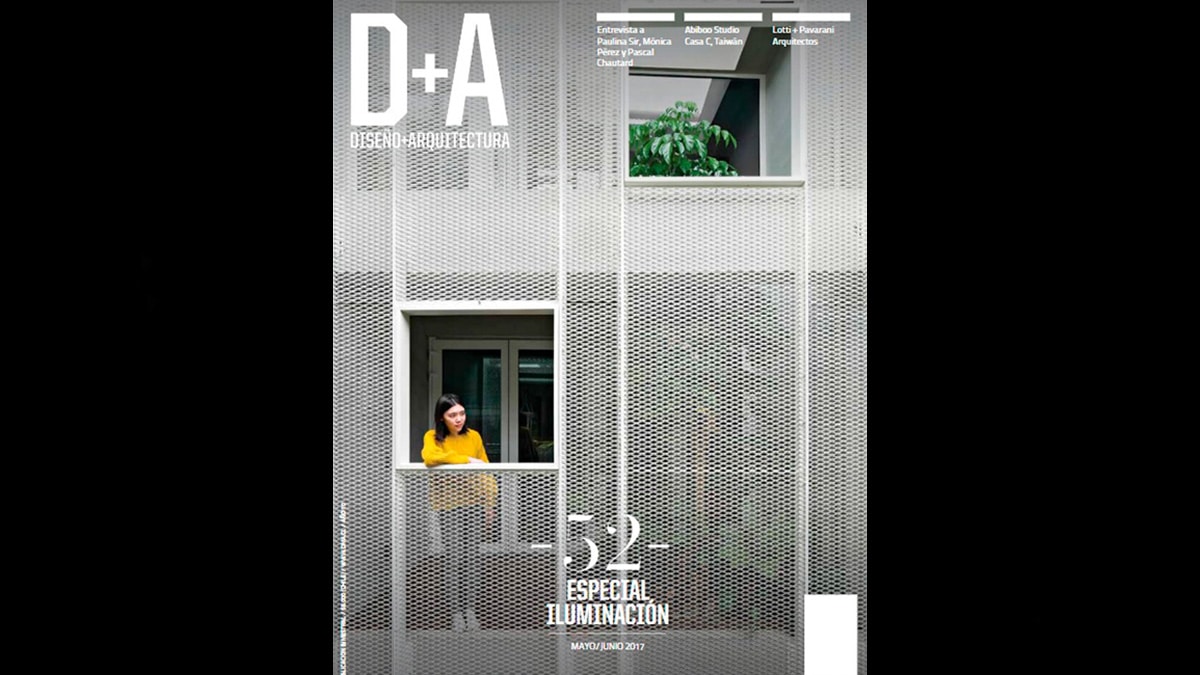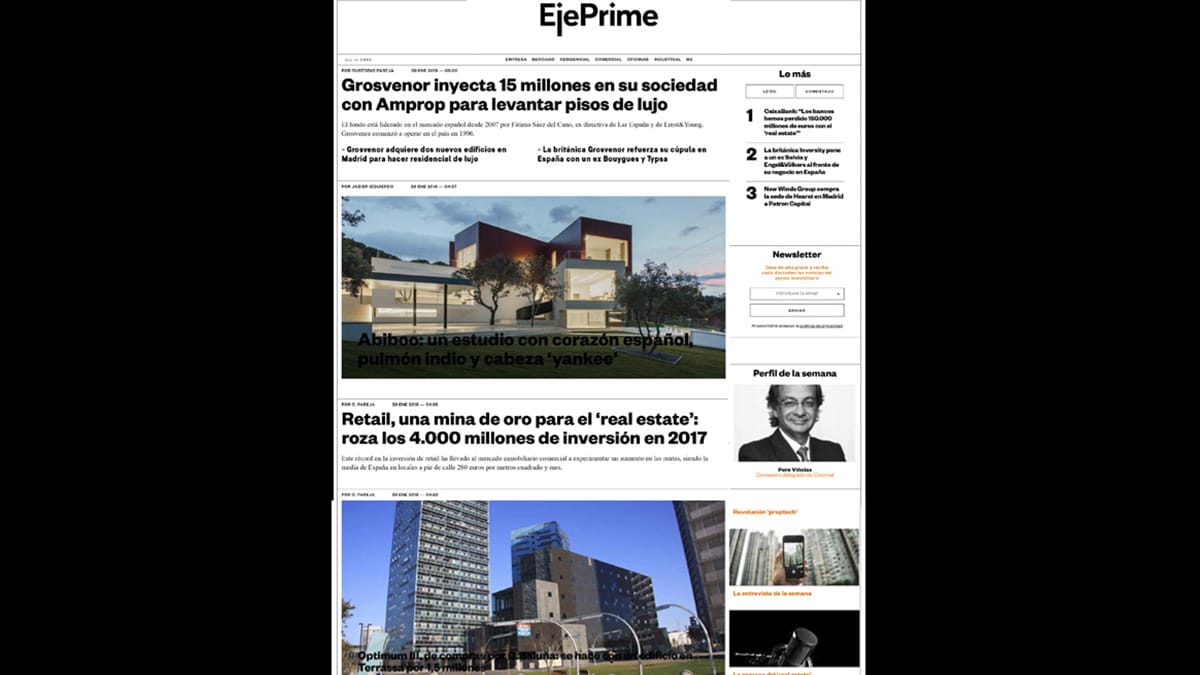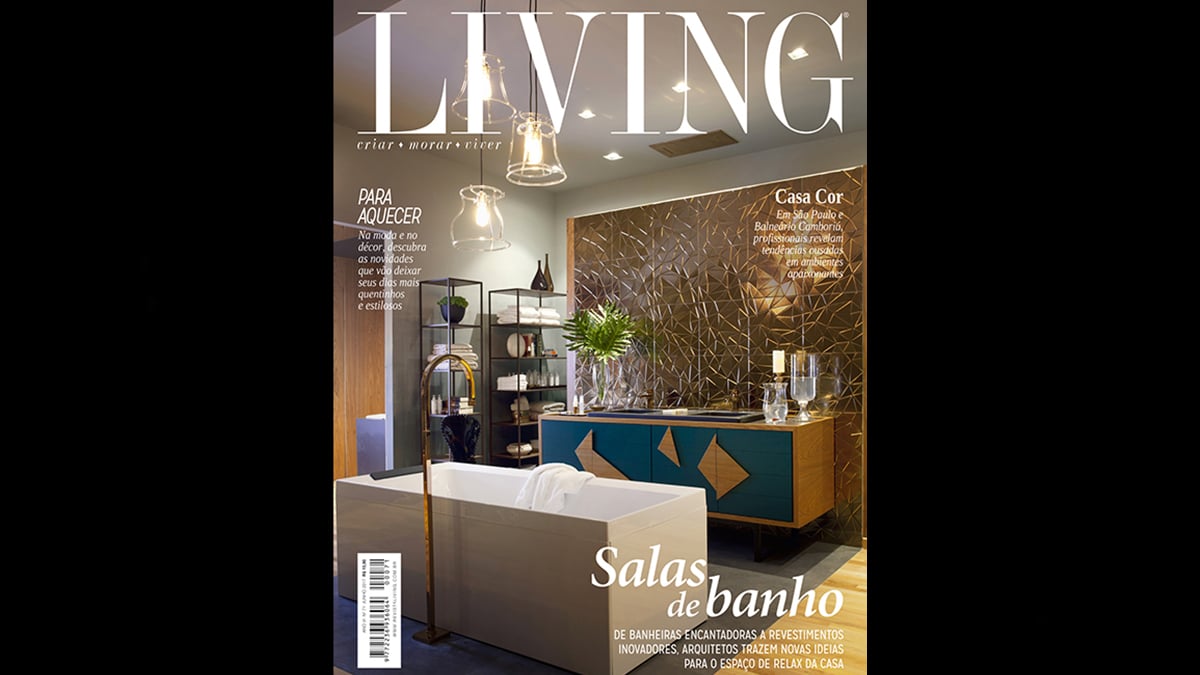Para español, leer debajo de las imágenes…
We would like to thank the team behind the book “Global Villa Design” for their interest in our work!
The text below is an excerpt from the publication. For the full article/ publication, please refer to the source indicated below.
Interview
Alfredo Munoz is an architect in Spain and an International Associate of the American Institute of Architects. He is the founder of ABIBOO Architecture and his practice and research focus on the development of integral processes at the intersection of arts, engineering, sensorial approach to architecture and anthropology. (…)
Which project has given you the most satisfaction thus far?
I loved working on our private villas. We have designed villas for sportspeople, diplomats, businessmen, actors and for “the neighbor next door”. I enjoy realizing that no matter what we do in our professional time, when it comes the time for our private space, we are all very similar in the emotions that we can build around them. I also enjoyed working on some of our largest projects, like the town entire townships we have designed in India for affordable homes. The retail and cultural projects are also of great fun because they take a larger impact on the city and its inhabitants. In the end, every project has its own soul and like children, it is difficult to choose among them.
(…)
What are your thoughts on the importance of renders in architecture today?
I see the renders as a communication tool. In many cases, they are useful to explain ideas to people that are not used to envision space. However, they lack the actual texture and materiality, which I consider essential in architecture. The texture and materials are so deeply associated with the tactile experience that they become a fundamental tool for my architecture.
(…)
Who has been the biggest influence on your work?
I believe my architecture has influences from two different directions. Christopher Alexander identified them in the 60s as “self-conscious architecture” and “unselfconscious architecture”. The first type is “designer architecture”. The second one is related to vernacular designs, an architecture whose designer us not identified. I love the research of authors like Bernard Rudofsky, also during the 60s, on “architecture without architects”. Charles Jencks proposes that these types of architecture are sometimes more important to architects than the one from designers that we all study in the books of Architecture. In my case, I agree these inspirations are the main source of my designs.
Once said that I also have learned from very important “Design Architects”. I had the luck to work in my youth with Toyo Ito — winner of the Pritzker Prize, with Inaki Abalos — Chair of Architecture at Harvard University, or with Skidmore, Owings & Merrill (SOM) — designers of the Burj Khalifa. I did learn a lot from all of these masters of the XX century and it would be impossible for me to be the architect that I am now without their direct influence. I am also passionate about the work of other architects from the past like Frank Lloyd Wright or Richard Neutra but the list is endless. I think I learn from everyone I come across either through books or in person.
I could identify two other influences in my way of thinking architecture. Phenomenology is closely related to my interests for strong experiential creation, and I do have a lot of debt to the ideas of many philosophers, writers and architects associated with these lines of thought. I also breathe and share interests associated with dynamic nonlinear processes, connected with the called “chaos theory”. However, I look at these theories from a different angle than many current architects do. Many postmodern architects are looking into ideas related to chaos theory with formal solutions like fractals, biomorphic non-Euclidean forms, or parametric designs. My interest associated with the “complexity of chaos” goes to the process itself, more than to the actual forms of architecture.
(…)
What is your overarching philosophy about architecture and design and how does it influence how you approach and work with clients?
Since the late Enlightenment and the ideas of Friedrich Hegel, architecture has been conceived as the way to represent the “spirit of a time” (Zeitgeist).
However, we now live in a society that is in permanent change. As Paul Valery wrote “Interruption, incoherence, and surprise are the ordinary conditions of our life and our minds are no longer fed by anything but sudden changes and constantly renewed stimuli… We no longer know how to make boredom bear fruit.”. How then to represent such an ever-changing world through architecture if there is nothing that lasts?
The search for an answer to this question is the main core of my architecture. I think Form was a fundamental part of design during the XX Century when the reality was more static, more solid. However, I believe that nowadays, and focus on form design will be obsolete too soon. My approach is that, if the sight stimuli through the form will come obsolete no matter what, we should then focus on the full sensorial and emotional experiences, which allow adaptability over time.
I think that vernacular Islamic Architecture has mastered this difficult solution better than any other in History. The castle of Alhambra in Spain, where I am originally from, is a masterful example of what I mean: the importance of the sound through water, or the touch of light, or the smell of introverted gardens that bring us closer to a deeper sense of being. I had the luck to spend many months of my childhood in Andalucía (former Al-Andalus) and learned early in life the unexplainable beauty of the non-visual experiences. The “immaterial” or shapeless elements in architecture that provide smell, touch, sound, taste and emotional connection with our deeper selves are something that is timeless, something that can bring us closer to a true representation of today’s changing Word.
Therefore, I would say that my goal is to create strong experiences that change in time, along with the people that interact with the architecture. This required a change in the focus. While most architects have focused before on space and form creation, I am more interested in physiology as processes. I like to say to my clients that an architect is more like a philologist or a sociologist. Before drawing anything, I spent countless hours talking with my clients or researching on the final consumers of my architecture. I want to know the deeper subconsciousness associated with the user so I can evoke something powerful through architecture. The solutions to this search are difficult to appreciate thought photos… I think it is an architecture to be experienced.
I acknowledge that by trying to go deep into the understanding of the subconsciousness some might think that my designs are too exclusive or personalized. I agree and I disagree at the same time. I believe than when one space has a very strong spirit or sense of emotional connection, it has so much character than anyone will enjoy it and appreciate it. I used to live in Japan working for Toyo Ito and one of his influencers, Kazuo Shinohara, used to say that if a space is really beautiful, it will adapt any type of future change in the program.
I agree with this point of view. A good example is in New York, where we have one of our ABIBOO offices. The loft space was associated with warehouses and manufacturing activities, but the space created is so powerful than now, it is a trendy way of doing residential projects. (…)
As a summary, my design philosophy is not to be attached to a form but a design process. A process that among many characteristics, gives great importance to sensorial and emotional experiences. I think the role of an architect is more to listen than to talk, it is more to sense the true spirit of a place, of the client’s needs and of the society itself. This will allow us to respond to the Zeitgeist of our world in permanent change.
The copyright of photos, images, videos, and ideas indicated in this Think Tank section belong to each artist/ creative studio/ company mentioned or referenced in the links below.
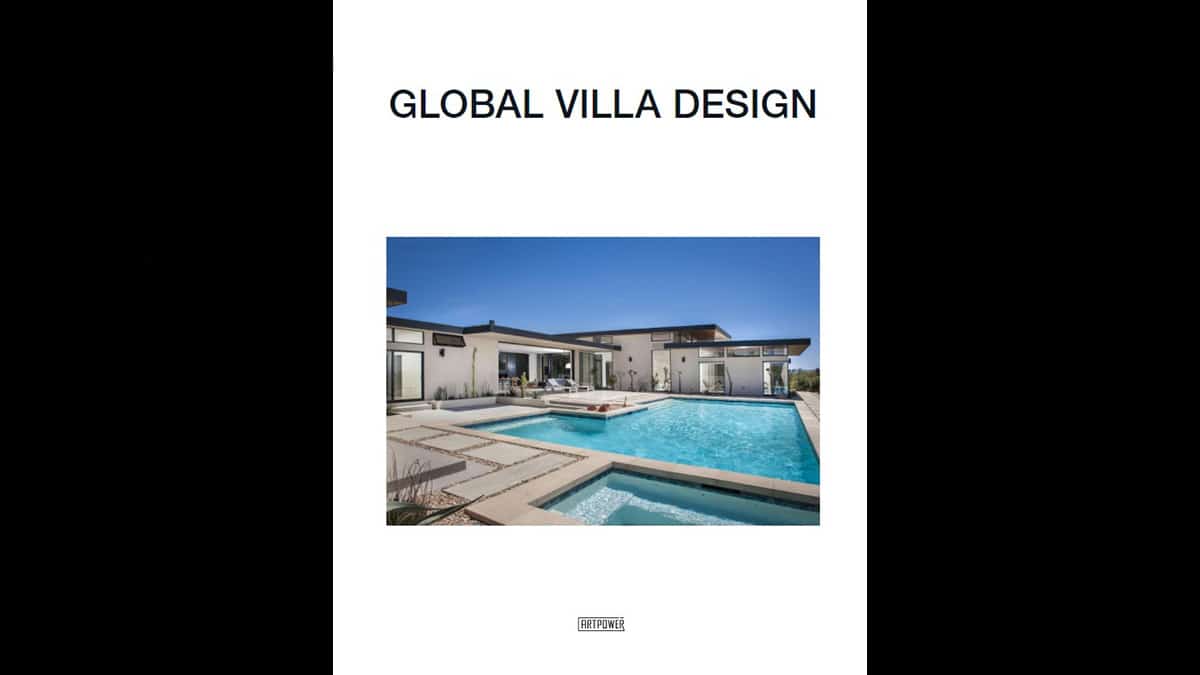

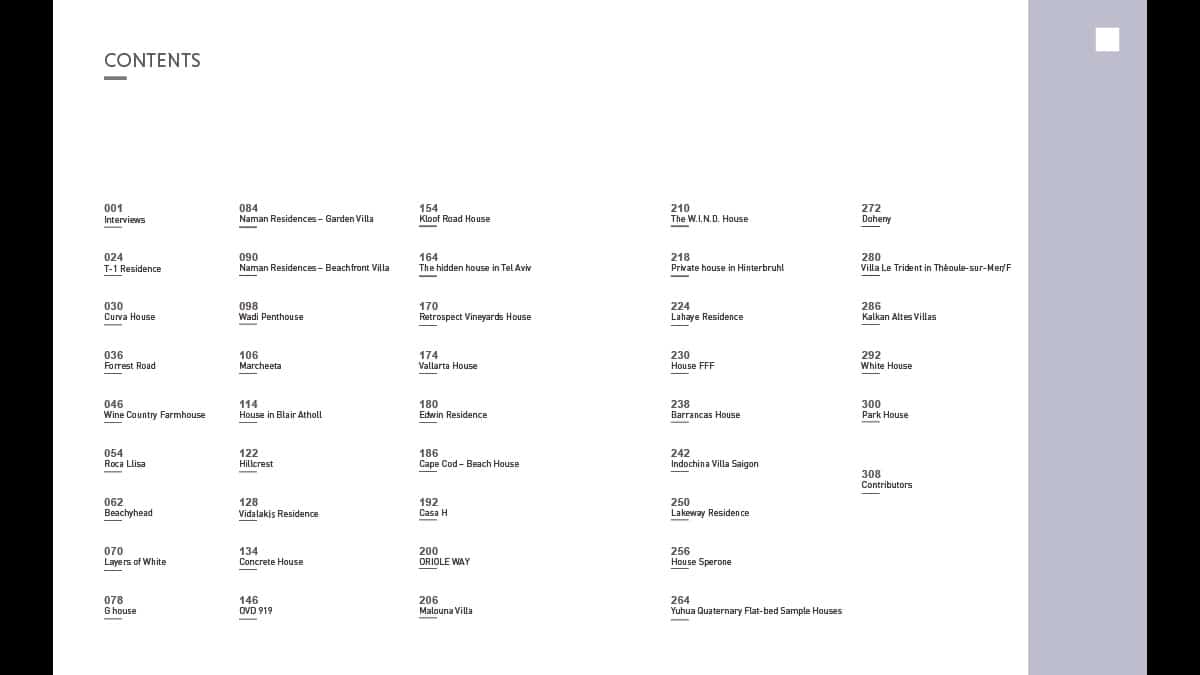
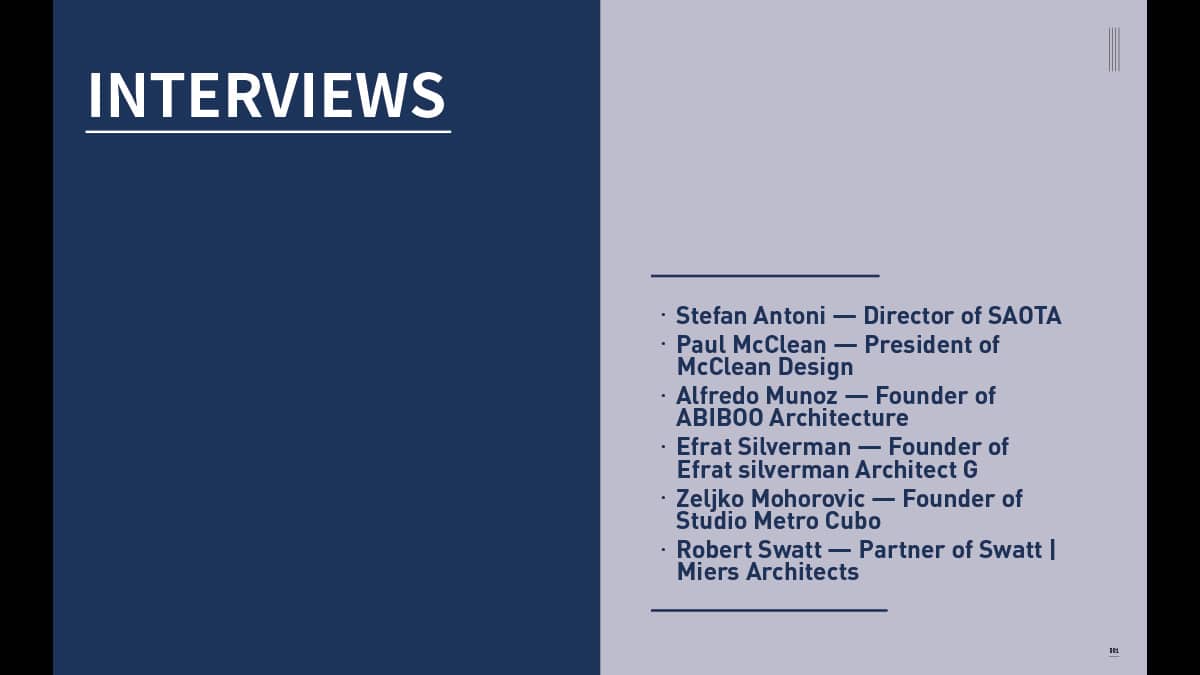
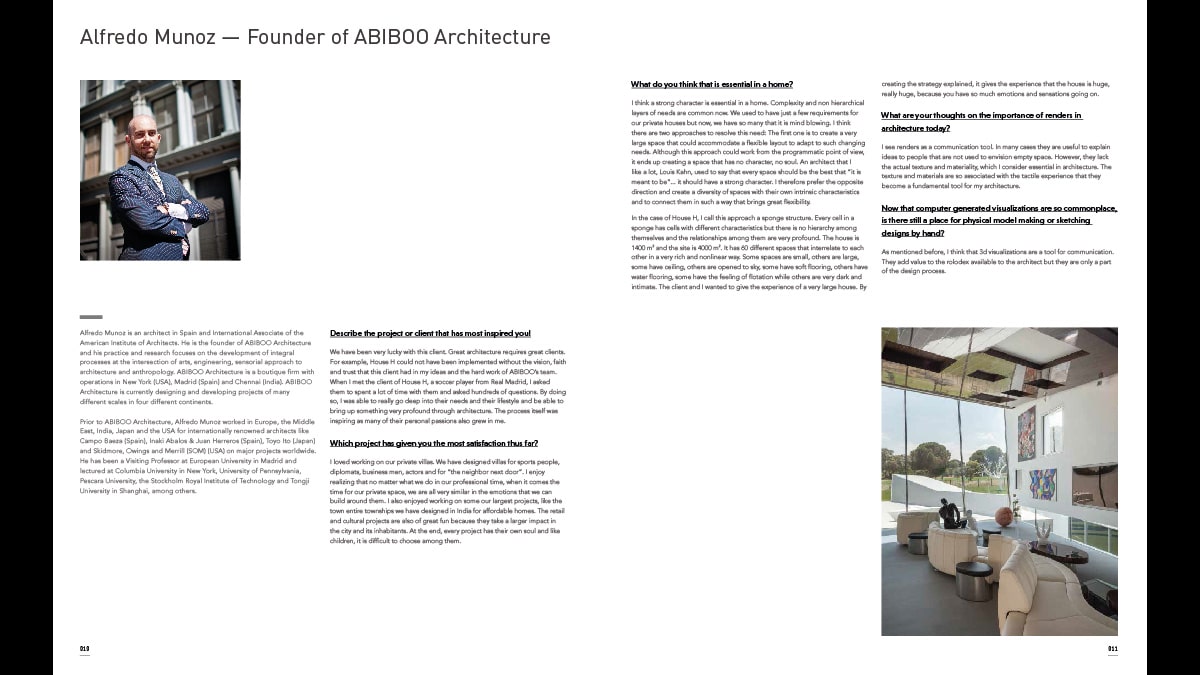
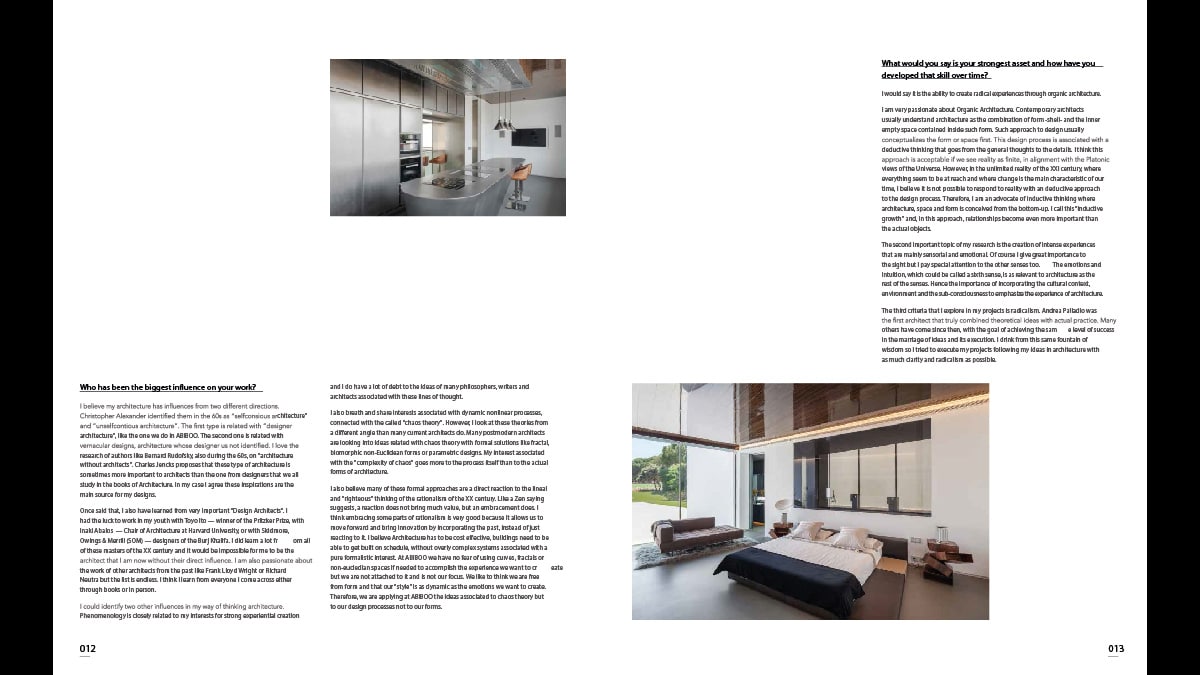
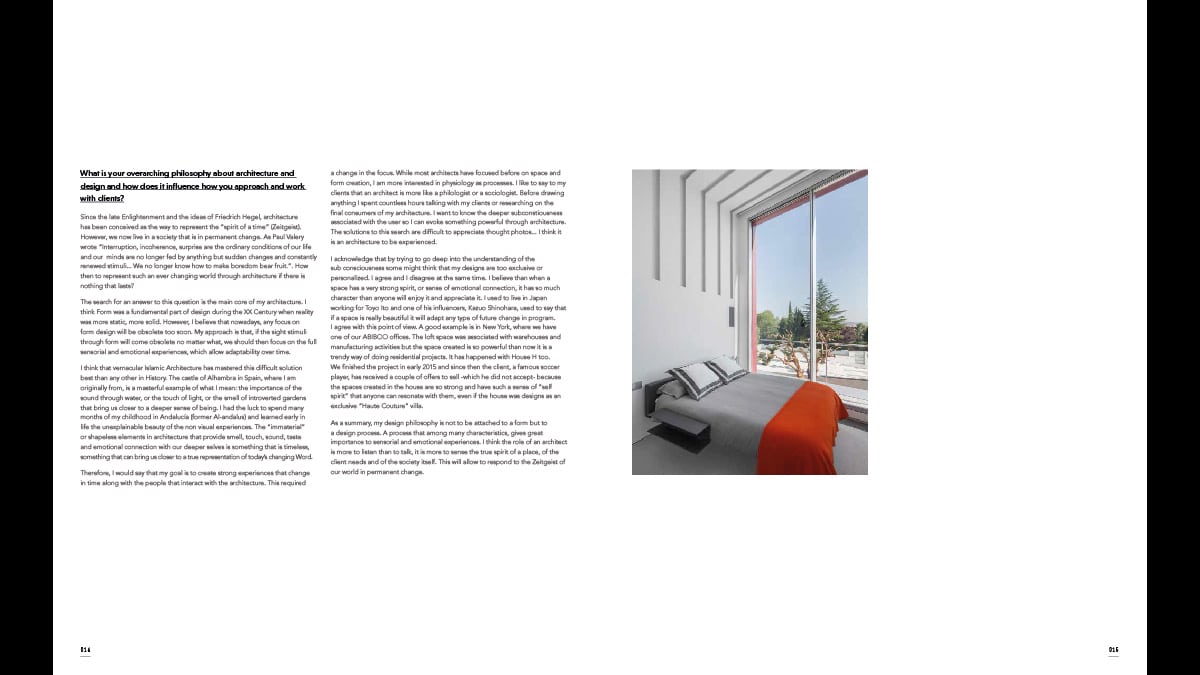

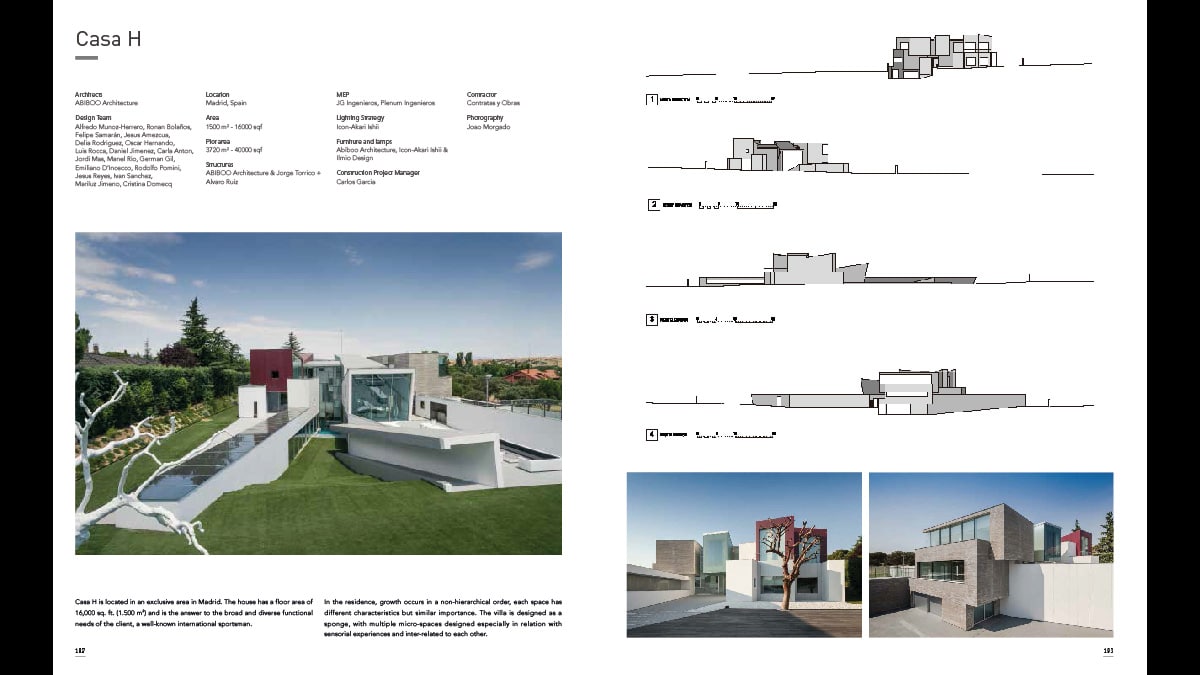
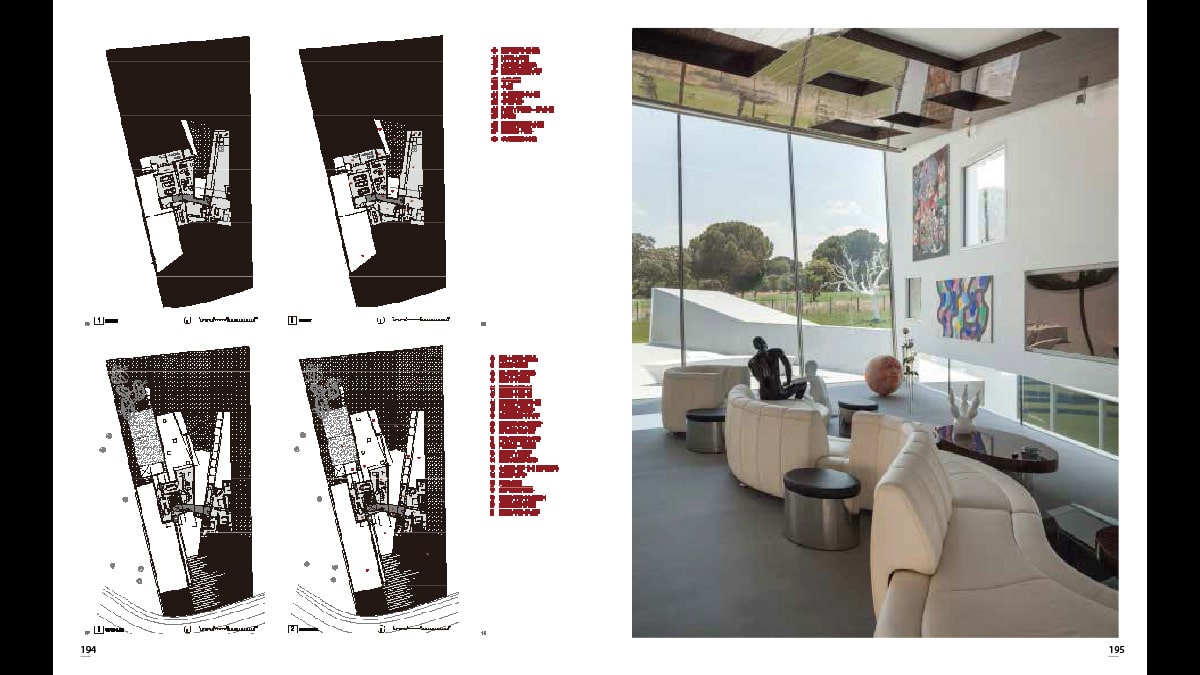
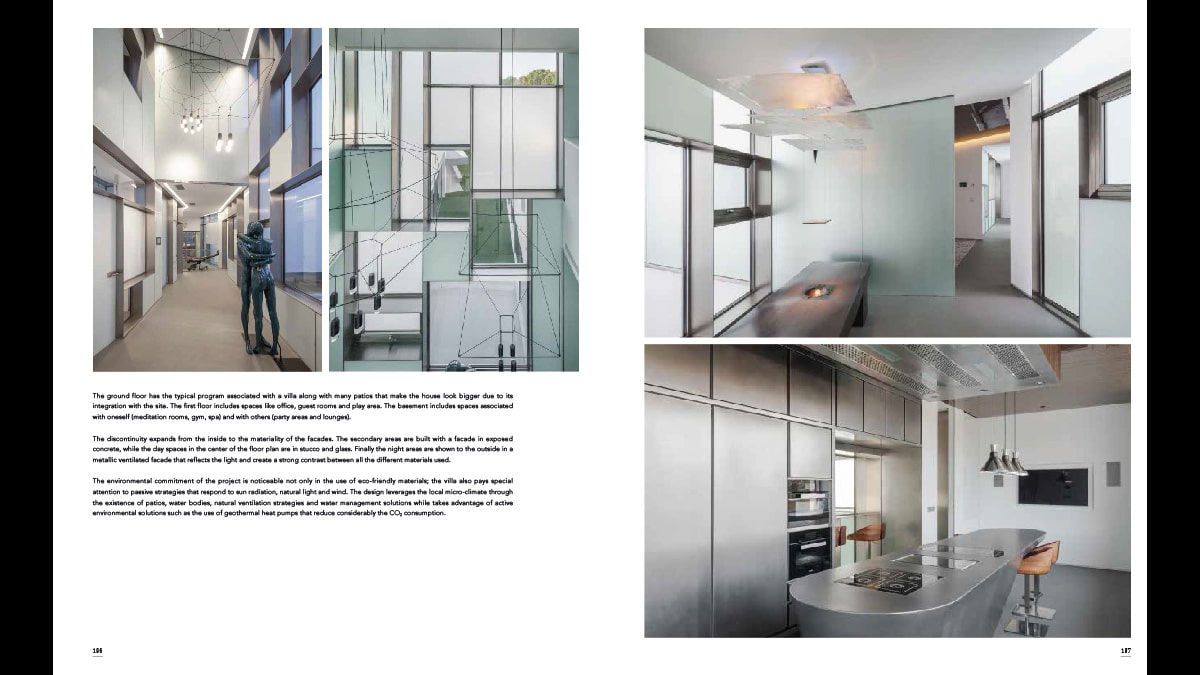
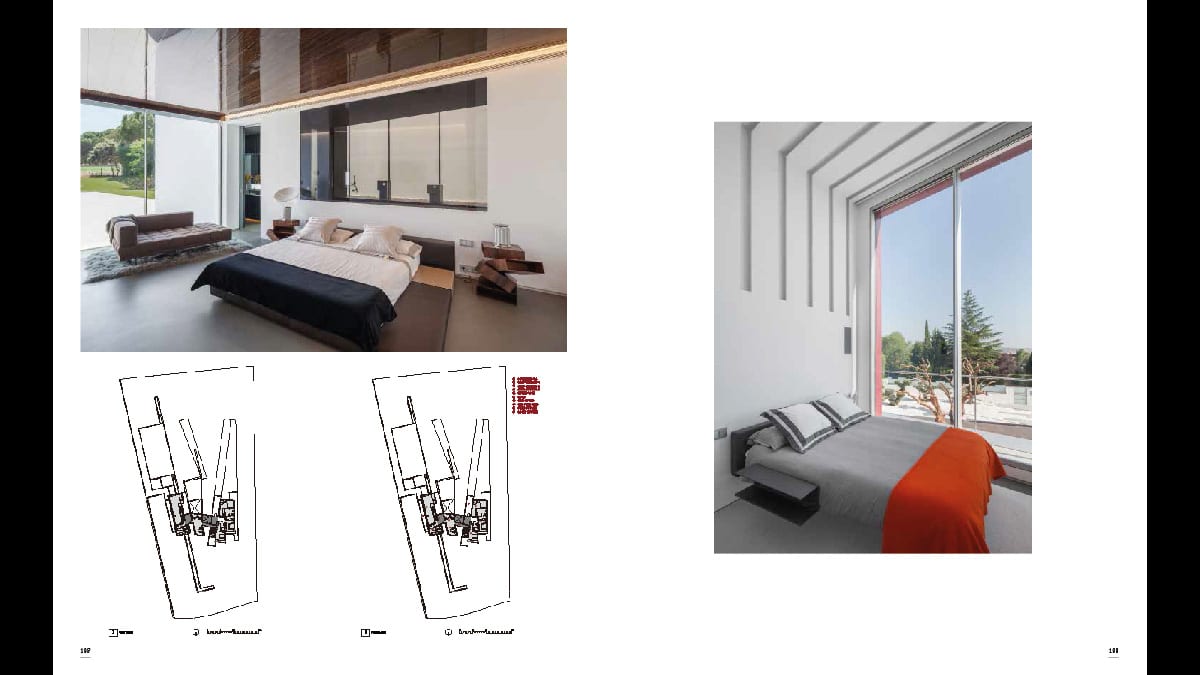

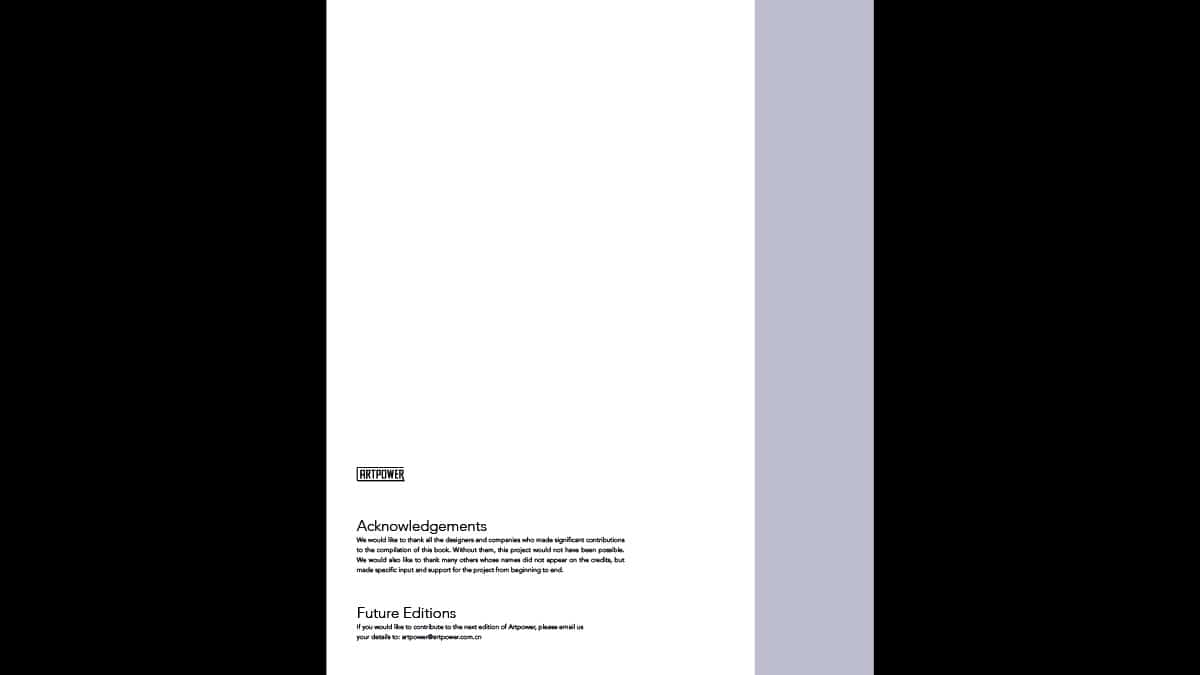
¡Nos gustaría agradecer al equipo detrás del libro “Global Villa Design” por su interés en nuestro trabajo!
El texto que sigue a estas líneas es un breve extracto de la publicación original. La publicación completa puede verse en las fuentes indicadas.
Entrevista
Alfredo Muñoz es un arquitecto en España y un asociado internacional del Instituto Americano de Arquitectos. Es el fundador de ABIBOO Arquitectura y su práctica e investigación se centran en el desarrollo de procesos integrales en la intersección de las artes, la ingeniería, el enfoque sensorial de la arquitectura y la antropología. (…)
¿Qué proyecto le ha dado más satisfacción hasta ahora?
Me encantó trabajar en nuestras villas privadas. Hemos diseñado villas para deportistas, diplomáticos, empresarios, actores y para “el vecino de al lado”. Disfruto al darme cuenta de que no importa lo que hagamos en nuestro tiempo profesional, cuando llega el momento de nuestro espacio privado, todos somos muy similares en las emociones que podemos construir a su alrededor. También disfruté trabajando en algunos de nuestros proyectos más grandes, como los urbanismos que hemos diseñado en la India para viviendas asequibles. Los proyectos de comercio y cultura también son muy divertidos porque tienen un mayor impacto en la ciudad y sus habitantes. Al final, cada proyecto tiene su propia alma y como los niños, es difícil elegir entre ellos.
(…)
¿Qué piensa de la importancia de los renders en la arquitectura actual?
Veo los renders como una herramienta de comunicación. En muchos casos, son útiles para explicar ideas a las personas que no están acostumbradas a imaginar el espacio. Sin embargo, carecen de la textura y la materialidad real, que considero esencial en la arquitectura. La textura y los materiales están tan profundamente asociados a la experiencia táctil que se convierten en una herramienta fundamental para mi arquitectura.
(…)
¿Quién ha sido la mayor influencia en su trabajo?
Creo que mi arquitectura tiene influencias de dos direcciones diferentes. Christopher Alexander las identificó en los años 60 como “arquitectura autoconsciente” y “arquitectura no autoconsciente”. El primer tipo es “arquitectura de diseño”. El segundo está relacionado con los diseños vernáculos, una arquitectura cuyo diseñador no identificamos. Me encanta la investigación de autores como Bernard Rudofsky, también en los años 60, sobre “arquitectura sin arquitectos”. Charles Jencks propone que estos tipos de arquitectura son a veces más importantes para los arquitectos que la de los diseñadores que todos estudiamos en los libros de Arquitectura. En mi caso, estoy de acuerdo en que estas inspiraciones son la principal fuente de mis diseños.
Una vez dije que también he aprendido de muy importantes “Arquitectos de Diseño”. Tuve la suerte de trabajar en mi juventud con Toyo Ito – ganador del premio Pritzker, con Iñaki Abalos – Catedrático de Arquitectura de la Universidad de Harvard, o con Skidmore, Owings & Merrill (SOM) – diseñadores del Burj Khalifa. Aprendí mucho de todos estos maestros del siglo XX y sería imposible para mí ser el arquitecto que soy ahora sin su influencia directa. También me apasiona el trabajo de otros arquitectos del pasado como Frank Lloyd Wright o Richard Neutra pero la lista es interminable. Creo que aprendo de todos los que me encuentro, ya sea a través de libros o en persona.
Podría identificar otras dos influencias en mi forma de pensar la arquitectura. La fenomenología está estrechamente relacionada con mis intereses por una fuerte creación experiencial, y tengo mucha deuda con las ideas de muchos filósofos, escritores y arquitectos asociados a estas líneas de pensamiento. También respiro y comparto intereses asociados con procesos dinámicos no lineales, relacionados con la llamada “teoría del caos”. Sin embargo, miro estas teorías desde un ángulo diferente al de muchos arquitectos actuales. Muchos arquitectos posmodernos están buscando ideas relacionadas con la teoría del caos con soluciones formales como los fractales, las formas biomórficas no euclidianas o los diseños paramétricos. Mi interés asociado con la “complejidad del caos” se refiere al proceso en sí mismo, más que a las formas reales de la arquitectura.
(…)
¿Cuál es su filosofía general sobre la arquitectura y el diseño y cómo influye en la forma de abordar y trabajar con los clientes?
Desde la última Ilustración y las ideas de Friedrich Hegel, la arquitectura ha sido concebida como la forma de representar el “espíritu de un tiempo” (Zeitgeist).
Sin embargo, ahora vivimos en una sociedad que está en permanente cambio. Como escribió Paul Valery “La interrupción, la incoherencia y la sorpresa son las condiciones ordinarias de nuestra vida y nuestras mentes ya no se alimentan de nada más que de cambios repentinos y estímulos constantemente renovados… Ya no sabemos cómo hacer que el aburrimiento dé sus frutos”. ¿Cómo entonces representar un mundo tan cambiante a través de la arquitectura si no hay nada que dure?
La búsqueda de una respuesta a esta pregunta es el núcleo principal de mi arquitectura. Creo que la forma fue una parte fundamental del diseño durante el siglo XX, cuando la realidad era más estática, más sólida. Sin embargo, creo que hoy en día, y el enfoque en el diseño de la forma será obsoleto demasiado pronto. Mi enfoque es que, si los estímulos de la vista a través de la forma se vuelven obsoletos sin importar qué, deberíamos entonces enfocarnos en las experiencias sensoriales y emocionales completas, que permiten la adaptabilidad a lo largo del tiempo.
Creo que la arquitectura islámica vernácula ha dominado esta difícil solución mejor que cualquier otra en la historia. El castillo de la Alhambra en España, de donde soy originario, es un ejemplo magistral de lo que quiero decir: la importancia del sonido a través del agua, o el tacto de la luz, o el olor de los jardines introvertidos que nos acercan a un sentido más profundo del ser. Tuve la suerte de pasar muchos meses de mi infancia en Andalucía (antiguo Al-Andalus) y aprendí temprano en la vida la belleza inexplicable de las experiencias no visuales. Los elementos “inmateriales” o sin forma en la arquitectura que proporcionan el olor, el tacto, el sonido, el sabor y la conexión emocional con nuestro ser más profundo son algo que es atemporal, algo que puede acercarnos a una verdadera representación de la Palabra cambiante de hoy.
Por lo tanto, diría que mi objetivo es crear experiencias fuertes que cambien en el tiempo, junto con las personas que interactúan con la arquitectura. Esto requería un cambio de enfoque. Mientras que la mayoría de los arquitectos se han centrado antes en el espacio y la creación de formas, yo estoy más interesado en la fisiología como procesos. Me gusta decir a mis clientes que un arquitecto es más como un filólogo o un sociólogo. Antes de dibujar nada, pasé incontables horas hablando con mis clientes o investigando sobre los consumidores finales de mi arquitectura. Quiero conocer el subconsciente más profundo asociado con el usuario para poder evocar algo poderoso a través de la arquitectura. Las soluciones a esta búsqueda son difíciles de apreciar en las fotos de pensamiento… Creo que es una arquitectura para ser experimentada.
Reconozco que al tratar de profundizar en la comprensión del subconsciente algunos podrían pensar que mis diseños son demasiado exclusivos o personalizados. Estoy de acuerdo y no estoy de acuerdo al mismo tiempo. Creo que cuando un espacio tiene un espíritu muy fuerte o un sentido de conexión emocional, tiene tanto carácter que cualquiera lo disfrutará y apreciará. Solía vivir en Japón trabajando para Toyo Ito y uno de sus influyentes, Kazuo Shinohara, solía decir que si un espacio es realmente hermoso, adaptará cualquier tipo de cambio futuro en el programa.
Estoy de acuerdo con este punto de vista. Un buen ejemplo es en Nueva York, donde tenemos una de nuestras oficinas de ABIBOO. El espacio del loft estaba asociado a almacenes y actividades de fabricación, pero el espacio creado es tan poderoso que ahora, es una forma moderna de hacer proyectos residenciales. (…)
En resumen, mi filosofía de diseño no es estar ligado a una forma sino a un proceso de diseño. Un proceso que entre muchas características, da gran importancia a las experiencias sensoriales y emocionales. Creo que el papel de un arquitecto es más escuchar que hablar, es más sentir el verdadero espíritu de un lugar, de las necesidades del cliente y de la propia sociedad. Esto nos permitirá responder al Zeitgeist de nuestro mundo en un cambio permanente.
Los derechos de autor de las fotos, imágenes, videos e ideas mostrados en esta sección pertenecen al correspondiente artista/ firma creativa/ empresa mencionada o referenciada en los correspondientes links indicados a continuación:
Source/ Fuente: Li Aihong (2018). Global Villa Design. Artpower International.


